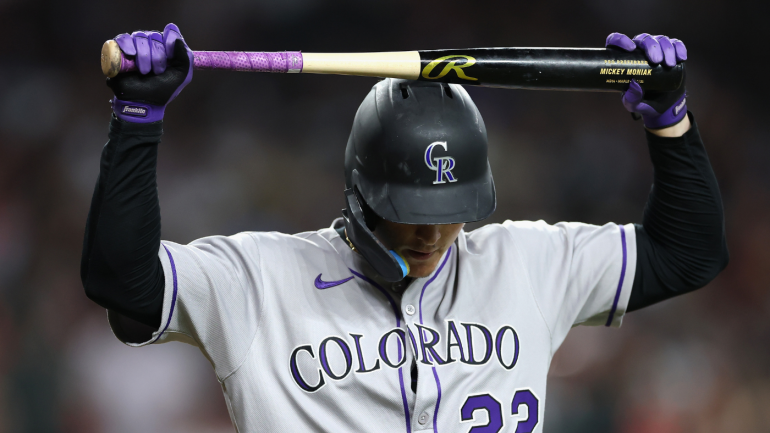

When it comes to inspiring gossip within the baseball industry, the Colorado Rockies are the unrivaled kings. Whether it’s the owner who responds to fan messages, or the analytics staffers pulling double-duty as clubbies, many of the stories spread about the Rockies by members of other front offices sound fabricated, right up until the time when their authenticity is confirmed. No development, no matter how outlandish, seems to land outside the foul line in Colorado.
Just as there is no ceiling on ludicrous stories generated by the Rockies organization, there appears to be no floor on their current squad. Indeed, Colorado enter Tuesday on pace to lose 134 games this season, 13 more than last year’s Chicago White Sox squad that posted the worst record in modern Major League Baseball history. The Rockies’ run differential (-150), meanwhile, is nearly twice as bad as the next worst team. There’s no sense denying that luck exists on both sides of extreme performance, but this Rockies team appears to be every bit as bad as their record indicates.
What sets the Rockies apart
You might wonder: just how did the Rockies end up here? And is there any hope for tomorrow? To answer the first part, you could do worse than keying in on pitcher Antonio Senzatela.
There’s never been a richer time in baseball history for pitching transformations. Through the use of ball-tracking data and slow-motion cameras, among other advancements in analytical and technological capacity, pitchers are reliably fashioning new offerings to add and additional tweaks to make. You wouldn’t know either was an option based on Senzatela’s career. Rather, he seems ossified against transformation, as first noted by Baseball Prospectus’ Mario Delgado Genzor. Five years ago, Senzatela had a 56% usage rate on his fastball, a 25% usage rate on his slider, and about a 20% usage rate combined on his changeup and curveball. So far this year, his usage rates on those pitches are: 54.5% four-seamer, 23.6% slider, and, yes, nearly 19% combined changeup and curveball.
All the while, Senzatela has seen his performance slip. He was once an above-average starter, but now he’s sporting an 84 ERA+ over his last 33 starts (a span that traces back through 2022). Most other pitchers in this predicament would attempt to reinvent themselves — by desire or choice. Not Senzatela, not under the Rockies’ watch. When this author noted as much to a rival front-office source, they responded by saying “someone has to have ideas.” Agreed, this author said, but no one there seems interested in using them. The source then clarified that they weren’t commenting on implementation or execution; instead, their perception is that there were simply no ideas to be found in the Rockies organization.
It’s hard to argue. The Rockies as an organization seem uninterested in evolving. High-altitude Coors Field remains an unsolved challenge, but these Rockies don’t seem particularly motivated to try anything different than what they’ve always done. There was a time, at least, where they would experiment. (Remember when they tried a four-pitcher rotation?) Not so much anymore, even at a time when their lineup has proven that it’s possible to post zero after zero in the league’s friendliest offensive environment. (As of this writing, the Rockies improbably rank 29th in runs scored.) Manager Bud Black, fired barely a week ago, wasn’t solely to blame for Colorado’s struggles, yet he’d likely remain if the Rockies were on pace for a ho-hum 100-loss campaign. Mediocrity isn’t accepted by the Rockies organization so much as it’s rewarded.
While other more successful organizations like the New York Yankees and St. Louis Cardinals stave off intellectual complacency, the Rockies haven’t hired a general manager from outside the organization since 1999. Their listed assistant general managers have each been with the organization since at least 2006, and every assistant to the general manager is a former Rockies player. (Don’t forget that their director of pro scouting is owner Dick Monfort’s son.) Monfort’s loyalty is commendable, but it’s not getting results. This is an organization that hasn’t made the playoffs since 2018, and hasn’t won a playoff series since a run to the World Series in 2007.
Doomed spending, bad scouting
To Monfort’s credit, he’s often spent money trying to change his franchise’s fortune. This year represents the first time the Rockies ranked outside of the top 20 in Opening Day payroll since 2015. But spending and spending wisely are two different things. The Rockies’ top five compensated players — Kris Bryant, Kyle Freeland, Ryan McMahon, Senzatela, and Germán Márquez — have combined for nearly two wins below replacement so far this season.
Those poor decisions are hardly a fluke. The Rockies have made questionable investments elsewhere. The last of their first-round picks to tally more than 5 WAR for their career was Brendan Rodgers, whose name was called nearly a decade ago. Ask any scouting director worth their salt which profiles are the riskiest and they’ll usually say prep catchers, prep right-handers, and first basemen (since the offensive bar is so high). The Rockies, undaunted by the fact that they face even higher attrition risks for pitchers than other clubs, have stocked up on those profiles. Colorado’s scouting department has burned seven of its last 12 first- or supplemental-round picks on first basemen, prep catchers, and pitchers (albeit not of the prep variety). No wonder they want for better big-league talent.
Rocky future
There are more examples, but the overarching point should be obvious by now. This Rockies organization seems untethered to results. A normal franchise would’ve made wholesale changes to its process and personnel. These Rockies don’t seem to know or don’t seem to care how far behind everyone else they’ve become. Which is worse? If there is hope for a better future, it exists in the possibility that this historical ineptitude will be treated with grave seriousness; that this can be learned from and avoided again in the future; that Monfort will view this as an existential shock that demands a response.
Introducing new thinkers and new thoughts may not change the Rockies’ fortune — at least not in an immediate sense — but it would seem more likely than if this season is written off as anything short of a long-term organizational failure to grasp reality. Unfortunately, when it comes to the Rockies, the hardest story to believe is the one that has them learning from their mistakes.
This news was originally published on this post .











Be the first to leave a comment